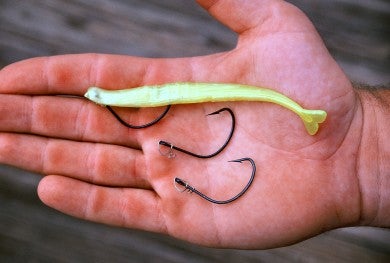Bedding Bass Tactics
Bob McNally 04.23.15

Heavyweight spawning largemouth bass now are being caught throughout many areas of the country as the fish move into shallow water fanning nests and making whoopee.
In recent years anglers have learned that small soft-plastic tube lures and soft-plastic lizard or crawfish imitation lures are very productive for spawning bass, including spooky ones in clear water.
One of the best bedding bass anglers around is Auburndale, Florida guide and BASS Master Classic tournament contender Carroll Hagood. One spring he caught-and-released over 50 bedding bass weighing more than 10 pounds.
Hagood uses tube baits and “craws” exclusively for bed fishing. He “sight fishes” for bass, meaning he searches shallow flats until he locates largemouth beds, and then only casts when he spies a huge fish on a bright, freshly-fanned depression.
Often he marks the bed with a small fishing float so he can move away from the site while casting to it, and thus not spook fish.
Carroll prefers using bright-colored tube or craw lures, like white, chartreuse, or silver with gold flecks. He says such lures are most easily seen when fishing a bed. Keeping a close eye on a tube or crawfish lure in a bed (requiring a brimmed cap and quality polarized sunglasses) allows an angler to see a bedding largemouth approach a lure and then take it, which tells an angler when to strike.
Tubes and craws 3 to 4 inches long, rigged weedless, Texas style on a 1/0 Eagle Claw HP hook, used with a 1/4 to 1/16 ounce bullet weight are ideal.
The lure is cast beyond a sighted bed, allowed to sink to bottom, and then slowly retrieved onto a bed and left there. Occasional twitches of a rod tip imparts a bit of tentacle action to a soft plastic tube or crawfish lure, which often entices large, reluctant bass to strike it.
While all tube and crawfish lures are deadly for bedding bass, ones with scent enhanced “flavors” are preferred by many anglers because bedding fish have a long time observing them on their nests before striking.
Catching and killing bass caught from spawning beds is about as controversial a subject as there is in fishing because, so goes the argument, anglers are stealing from the fish that’s laying the golden eggs.
Further, some people compare a population of big bass in a fishery to mature bucks in a deer herd. If a landowner shoots every little 6-point buck he sees in his corn field it’s sure to cut down his chances of taking an old 12-point buck on his property.
Similarly, if a bass fisherman catches and keeps every 5-pounder he sees on spawning beds in spring, odds are pretty good not many fish will grow to 8-pounds or more.
Logic such as this is why some states have closed seasons on bass. Most of the time their seasons don’t even open for bass until fish have completed spawning. Some fisheries departments realize it takes a long time for bass to grow large, and the easiest time to catch big bass is when they’re spawning. To protect large, mature fish, they halt angling pressure while bass are most vulnerable: during the spawn.
But there are many states where it’s lawful to fish for bedding bass and keep them if you want to. In addition, there are a number of states that allow anglers to fish for bedding bass, but all such fish must be released.
In any case, the answer to this trophy bass dilemma is as follows: when a giant largemouth is caught from a bed, make a photograph of it. Then release the bass unharmed.
It’s sort of like having your bass, but letting it go, too.
